

Most ebook files are in PDF format, so you can easily read them using various software such as Foxit Reader or directly on the Google Chrome browser.
Some ebook files are released by publishers in other formats such as .awz, .mobi, .epub, .fb2, etc. You may need to install specific software to read these formats on mobile/PC, such as Calibre.
Please read the tutorial at this link: https://ebookbell.com/faq
We offer FREE conversion to the popular formats you request; however, this may take some time. Therefore, right after payment, please email us, and we will try to provide the service as quickly as possible.
For some exceptional file formats or broken links (if any), please refrain from opening any disputes. Instead, email us first, and we will try to assist within a maximum of 6 hours.
EbookBell Team

4.3
38 reviewsLearn to deploy and support Hyper-V, building on what you know about VMware's vSphere. Whether you're looking to run both hypervisors in parallel or migrate completely, Hyper-V for VMware Administrators has everything you need to get started.
The book begins with an overview of Hyper-V basics, including common management tasks such as creating a virtual machine and building a virtual network. You'll learn how to deploy a failover cluster to protect against the risk of Hyper-V becoming a single point of failure, and how to make virtual machines fault tolerant. System Center Virtual Machine Manager (SCVMM) is the preferred tool for managing large Hyper-V deployments, so you'll get to know this next and how it differs from VMware's vCenter solution, as well as how to manage a mixed environment including both vSphere and Hyper-V deployments.
Like any server migration, a virtual server migration requires careful planning to ensure success. You'll find information here on the specifics of migrating from vSphere to Hyper-V, planning for down time, IP address differences, performance considerations, and more. For migrations to Hyper-V, SCVMM is once again the preferred tool, but you'll also be introduced to some of the excellent free tools available.
One easily overlooked aspect of the migration process is the way in which it impacts your backup and recovery strategy. Knowing the best practices here can help you protect your Hyper-V environment. The book also covers how to monitor and maintain your Hyper-V environment once it's up and running, using features like Cluster-Aware Updating, automated live migrations, and availability sets. The concluding chapter shows you how to take advantage of the efficiencies provided by virtual machine libraries and templates.
Approach Hyper-V with confidence, and the knowledge that you've planned for success, with Hyper-V for VMware Administrators.
What you’ll learnReaders should have a working knowledge of vSphere 5.5. No prior experience with Hyper-V is expected. Table of Contents
Chapter 1: Hyper-V Basics
Chapter 2: Building a Failover Cluster
Chapter 3: An Introduction to System Center Virtual Machine Manager (SCVMM)
Chapter 4: Hyper-V and vSphere Coexistence with SCVMM
Chapter 5: Using SCVMM for vSphere Migrations
Chapter 6: Other Tools for Migrating Virtual Servers to Hyper-V
Chapter 7: Hyper-V Backup Best Practices
Chapter 8: Keeping Hyper-V Healthy
Chapter 9: Virtual Machine Libraries and Templates